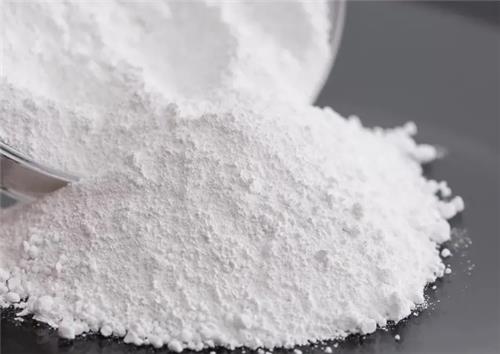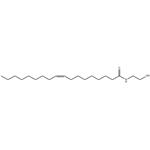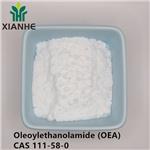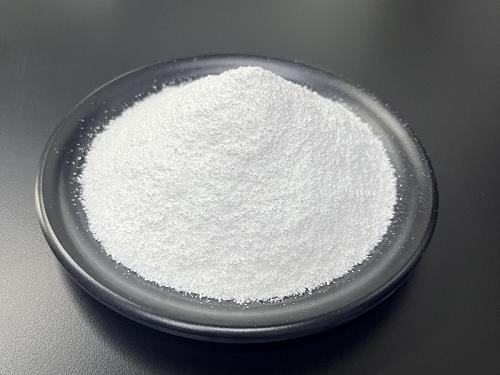Oleoyl Ethanolamide: Anti-Inflammatory & Metabolic Regulatory Effects
Oleoyl ethanolamide is an N-(long-chain-acyl)ethanolamine that is the ethanolamide of oleic acid. The monounsaturated analogue of the endocannabinoid anandamide. It has a role as a PPARalpha agonist, an EC 3.5.1.23 (ceramidase) inhibitor and a geroprotector. It is a N-(long-chain-acyl)ethanolamine, an endocannabinoid and a N-acylethanolamine 18:1. It is functionally related to an oleic acid. Systemic administration of Oleoyl Ethanolamide suppresses food intake and reduces weight gain in rats (10 mg/kg intraperitoneally) and PPARα wild-type mice, but not in PPARα knockout mice. These data indicate that OEA regulates food intake by a PPARα-mediated mechanism.

The Effect of Oleoyl Ethanolamide Add-On Treatment on Inflammatory
Oleoyl Ethanolamide (OEA) is a member of the N-acylethanolamine (NAE) family, which are endogenously bioactive lipids and are formed from amidation of membrane phospholipids. This fatty acid is mostly found in sources such as olives and sesame. Pure olive oil counteracts cell death by reducing lipid peroxidation (LPO), brain prostaglandin E2, and nitric oxide production, while increasing glutathione concentrations. The members of the NAE family have been identified as the natural ligands of the CBR. In addition to the CBR, OEA can bind to PPAR-α, and consequently, exert its anti-inflammatory effects, since PPAR-α acts as a negative regulator of the inflammatory response through direct binding to the p65–nuclear factor (NF)-κB, which subsequently antagonizes NF-κB transcription factor pathways. This study sought to determine the effect of Oleoyl Ethanolamide supplementation on the biomarkers of OS, inflammatory parameters, lipid profile, and renal and hepatic parameters in patients with acute ischemic stroke. Patients were randomly divided into three groups using Minitab software, patients who received Oleoyl Ethanolamide 300 mg/day, 600 mg/day, or placebo capsules with respect to concealment, respectively. All three groups received the treatment for three consecutive days. Each individual received a computer code, and the code was disclosed during the treatment period. [1]
Oleoyl Ethanolamide is derived from the unsaturated fatty acid oleic acid, which is part of MUFA. This fatty acid is mostly found in olives and sesame. In an experimental study on the effect of high MUFA diet on cerebral ischemia, an improvement was observed in the neurological and motor function in acute ischemic stroke mice models receiving olive oil fatty acid supplements compared to placebo. Although the neuroprotective effects of Oleoyl Ethanolamide after acute cerebral ischemic injury in the experimental model have been reported, to the best of our knowledge, there are no clinical trials on humans to prove this concept. It has been indicated that OEA (40 mg/kg, intraperitoneally (ip)) attenuates apoptosis by inhibiting the Toll-like receptor (TLR4)/NF-κB and ERK1/2 signaling pathways in mice model of acute ischemic stroke. The changes in inflammatory markers after treatment with OEA might be an indication of reduction in brain tissue inflammation happening after acute ischemic stroke.Our results indicate that Oleoyl Ethanolamide add-on to standard acute ischemic stroke treatment improves the short-term inflammatory, OS status, and lipid and biochemical parameters in those patients, particularly in moderate dosage, 300 mg/day, which might lead to the better functional outcome.
Oleic acid-derived Oleoyl Ethanolamide
Fatty acid ethanolamides, or N-acylethanolamines (NAEs), are a class of naturally occurring bioactive lipid signaling molecules derived from saturated and unsaturated fatty acid precursors. Examples of NAEs include arachidonoylethanolamide (AEA) or anandamide, palmitoylethanolamide (PEA), docosahexaenoylethanolamide (DHEA), and Oleoyl Ethanolamide (OEA). The objective of this article is to review the evidence of the effects of dietary oleic acid and OEA on body composition and energy metabolism, with an emphasis on recent results from human dietary intervention trials. Plausible mechanistic underpinnings of the clinical fat distribution outcomes are described, including OEA's effects on lipid metabolism and energy intake. Additional topics include OEA biosynthesis, catabolism, and regulation, as well as its association with dietary intake. We conclude with considerations for future studies and acknowledge literature gaps that should be resolved before Oleoyl Ethanolamide is considered in nutritional contexts as a weight management tool and therapeutic target for obesity and related disease treatment.[2]
Oleic-acid derived Oleoyl Ethanolamide is an endogenous lipid mediator that binds to PPAR-α. The downstream metabolic effects of PPAR-α activation include promotion of fat utilization and food intake control. Intake of oleic acid, predominately found in canola and olive oils, as well as high-oleic acid vegetable oils, enhances OEA levels by increasing precursor substrate availability for endogenous OEA synthesis. Numerous clinical trials of high-oleic acid dietary interventions report beneficial changes in body composition, particularly regional fat distribution, and, in some cases, increased fat oxidation. The data are supported by results in controlled animal models that demonstrate Oleoyl Ethanolamide stimulates fat uptake, lipolysis, and β-oxidation.
References
[1]Sabahi M, Ahmadi SA, Kazemi A, Mehrpooya M, Khazaei M, Ranjbar A, Mowla A. The Effect of Oleoylethanolamide (OEA) Add-On Treatment on Inflammatory, Oxidative Stress, Lipid, and Biochemical Parameters in the Acute Ischemic Stroke Patients: Randomized Double-Blind Placebo-Controlled Study. Oxid Med Cell Longev. 2022 Sep 8;2022:5721167. doi: 10.1155/2022/5721167. PMID: 36120593; PMCID: PMC9477639.
[2]Bowen, Kate J et al. “Oleic acid-derived oleoylethanolamide: A nutritional science perspective.” Progress in lipid research vol. 67 (2017): 1-15. doi:10.1016/j.plipres.2017.04.001
You may like
Lastest Price from Oleoyl Ethanolamide manufacturers

US $0.00/KG2025-11-28
- CAS:
- 111-58-0
- Min. Order:
- 0.1KG
- Purity:
- 98%
- Supply Ability:
- 100KGS

US $0.00/kg2025-04-28
- CAS:
- 111-58-0
- Min. Order:
- 1kg
- Purity:
- 0.99
- Supply Ability:
- 1000kg

